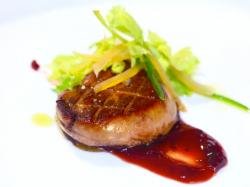The Physiology of Foie: Why Foie Gras is Not Unethical
January 6, 2011 | 1 min to read

I haven't always been comfortable with foie gras, though I've spent a good chunk of my life working with it. At first, the discomfort was with the taste. I tried it first as a teenager in the form of a cold terrine that tasted mostly of cat food to me. Then again, I also hated mayonnaise, brussels sprouts, and fish at the time, so my young opinion could hardly be trusted. Later on, as my culinary career expanded, I learned to love it.
I learned to appreciate how it spreads like the world's most decadent and flavorful butter when served cold as a torchon. I learned to appreciate how when it's served hot, it's crisp, sweet, and savory, and melts in your mouth like no other food in the world. And then I learned how it's produced. How in order to get the liver to expand to a good 600% of its natural size, the ducks must be force-fed in a practice known as gavage, wherein a long metal tube (like the one on the right) is forcibly inserted into the duck's mouth up to three times a day and a large amount of food is crammed into its gullet until the liver becomes so large that it takes up the vast majority of the bird's body cavity.
To read the rest of the story, please go to: Serious Eats.
